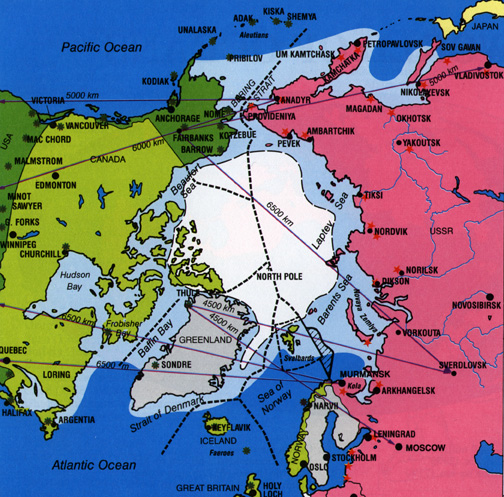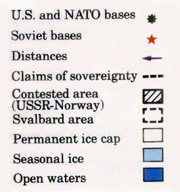|
The Impact of U.S. Aerial Reconnaissance during the Early Cold War (1947-1962): Service & Sacrifice of the Cold Warriors Chapter 2 The Need to Know Within a few days of the Pacific war’s end in September 1945, 15 Soviet fighters challenged a U.S. photo reconnaissance mission over the Japanese-held Kurile Islands. SAC units began flying reconnaissance missions along the Soviet rim as early as June 1946 from Ladd Air Base in Fairbanks. They were flown by the 46th Reconnaissance Squadron Very Long Range (Photographic) flying F-13 aircraft. (25) Aerial reconnaissance began under the auspices of collecting intelligence information to support U.S. war planning. As the Cold War heated up, national leaders turned to early aerial reconnaissance’s men and machines as a means to answer strategic concerns relating to the security of the U.S. and to assist them in formulating the direction of national security policy. |
|||||||||||
 |
|||||||||||
|
Arctic View of U.S./USSR Dispositions (26) Source: Chaliand, 62. |
|||||||||||
 |
|||||||||||
|
Military war-planning after WW II was centered on preparations for a future conflict with what military and civilian leaders perceived as our primary adversary–the Soviet Union. The U.S. experience in strategic bombardment and its new monopoly on atomic weapons would be the two main considerations for the nation’s security. Another prime reason for relying on these two instruments of national power was the dramatic demobilization of U.S. conventional military forces immediately following World War II. By February 1946, the JCS approved plans to bring the U.S. Army down to 670,000 personnel and set a goal for the USAAF to be manned at 400,000 personnel in 70 groups in 1947. (27) Reaching this goal would be difficult because the USAAF was experiencing the same shortfalls as the other branches of the U.S. Armed forces. By May 1947, the USAAF fell to 303,000 personnel in 38 manned and equipped groups. (28) Even though SAC was the premier command in the Air Force and the nation’s first line of defense/offense, it also suffered through post WW II demobilization and was in the same bad shape as the rest of the armed forces. In the years between 1946 and 1947, when the USAAF was transforming itself into the USAF, SAC consisted of approximately 40,000 personnel, a half dozen B-29 (Superfortress) bomber groups (29), one atomic-capable “silver-plated” B-29 bomber group, two aerial reconnaissance groups and a small number of transportation and fighter aircraft. (30) |
|||||||||||
 |
|||||||||||
|
Source: Larry Davis, B-29 Superfortress in Action (Carrollton: Squadron/Signal Publications, Inc.), 31 |
|||||||||||
|
When SAC was created in 1946, its initial reconnaissance forces consisted mostly of F-2 reconnaissance aircraft (which were the photo variant of Beech light transports). By 1947 SAC had acquired one F-9 squadron (12 photo-reconnaissance configured B-17 bomber aircraft) and one F-13 squadron (photo- reconnaissance configured B-29 bomber aircraft). The F-13’s were later re-designated as RB-29’s and would be configured as ELINT and COMINT (SIGINT) platforms as well. (31)
The capabilities of these early reconnaissance aircraft, while not yet in the jet age, were adequate for their initial tasks (see Appendix B for list of early reconnaissance aircraft capabilities). The best platform was the F-13/RB-29 which weighed more empty (about 70,000 pounds) than a fully-loaded B-17 but had double the B-17’s range (a combat radius of about 2,000 miles). At altitudes above 30,000 feet and traveling up to 350 miles per hour, the F--13/RB-29 was difficult for a WW II-era fighter to intercept. These early reconnaissance aircraft would be relatively safe from any Soviet interception until the jet-powered MiG-15 interceptor entered service in late 1948. (32) |
|||||||||||
|
Attributions (25) Ken White, World in Peril: The Origins, Mission & Scientific Findings of the 46th/72nd Reconnaissance Squadron (Indiana: K. W. White & Associates, 1994), 5. End of Page 3 of 5 Pages, Chapter 2 — Go to Page 4 You may go to Page — 1 — 2 — 3 — 4 — 5 — this chapter or you may go to Cover Page — Editor’s Introduction — Overview Acknowledgments — Table of Contents Appendixes — A — B — C — D |
|||||||||||